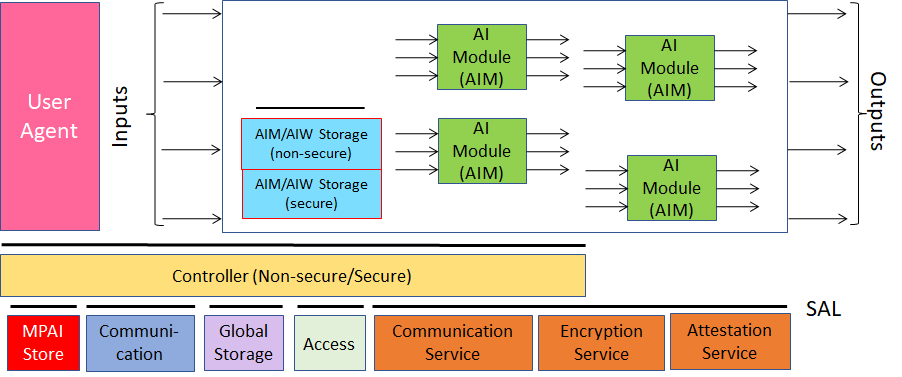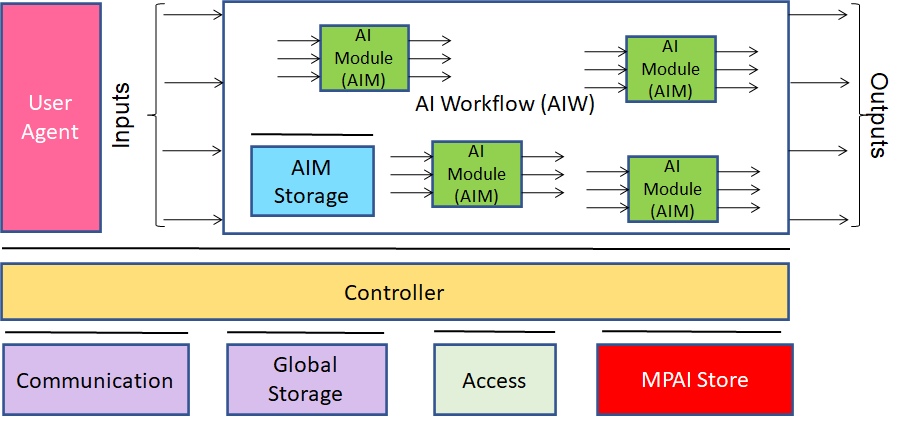This page provides an introduction to Technical Specification: Artificial Intelligence Framework (MPAI-AIF) standard. Also see the official MPAI-AIF homepage. and the MPAI-AIF V2.0 specification.
MPAI-AIF specifies an infrastructure – AI Framework – enabling access to the MPAI Store for downloading AI Workflows (AIW) and AI Modules (AIF) and executing implementations of MPAI Standards. So far, two MPAI-AIF Versions have been published: MPAI-AIF Version 1 – Version 2
Technical Specification: AI Framework (MPAI-AIF) V2 specifies a set of trusted services enabling AIF Components to access trusted services via APIs overcoming the limitation of AIF V1 where the whole AI Framework was assumed to run in a Trusted Zone but no security service was provided.
Currently MPAI-AIF V2 supports:
- Trusted Communication Service
- Encryption Service
- Attestation Service.
Figure 2 represents the Reference Model of MPAI-AIF V2.

Figure 2 – Reference Model of MPAI-AIF V2
The functionalities of the Security Profile defined by MPAI-AIF V2 on top of the Basic Profile defined in MPAI-AIF V1 are:
- The Framework provides access to the following Trusted Services:
- A selected range of cyphering algorithms.
- A basic attestation function.
- Secure storage (RAM, internal/external flash, or internal/external/remote disk).
- Certificate-based secure communication.
- The AIF can execute only one AIW containing only one AIM. The AIM has the following features:
- The AIM may be a Composite AIM.
- The AIMs of the Composite AIM cannot access the Secure API.
- The AIF Trusted Services may rely on hardware and OS security features already existing in the hardware and software of the environment in which the AIF is implemented.
Read An overview of AI Framework (MPAI-AIF)
Download Technical Specification – AI Framework (MPAI-AIF) V2
MPAI-AIF Version 1 – Version 2
Version 1: Figure 1 depicts the MPAI-AIF Reference Model where an AIF Implementation executes AI Workflows (AIW), composed of basic processing elements called AI Modules (AIM).

Figure 1 – Reference Model of MPAI-AIF V1
MPAI Application Standards normatively specify Syntax and Semantics of the input and output data and the Function of the AIW and the AIMs, and the Connections between and among the AIMs of an AIW.
In particular, an AIM is defined by its Function and data, but not by its internal architecture, which may be based on AI or data processing, and implemented in software, hardware or hybrid software and hardware technologies.
The MPAI AI Framework (MPAI-AIF) Technical Specification specifies architecture, interfaces, protocols and Application Programming Interfaces (API) of an AI Framework (AIF), especially designed for execution of AI-based implementations, but also suitable for mixed AI and traditional data processing workflows.
MPAI-AIF possesses the following main features:
- Independence from the Operating System.
- Component-based modular architecture with standard interfaces.
- Interfaces encapsulate Components to abstract them from the development environment.
- Interface with the MPAI Store enables access to validated Components.
- Component can be Implemented as:
- Software only, from MCUs to HPC.
- Hardware only.
- Hybrid hardware-software.
- The features of Component system are:
- Execution in local and distributed Zero-Trust architectures.
- Possibility to interact with other Implementations operating in proximity.
- Direct support to Machine Learning functionalities.
The MPAI-MMC Technical Specification has been developed by the MMC Development Committee (AIF-DC) chaired by Andrea Basso (Synesthesia).The MPAI-AIF Technical Specification and a Reference Software implementation are available for download.
If you wish to participate in this work you have the following options
- Join MPAI
- Actively participate in the reference software implementation by sending an email to the MPAI Secretariat.
- Keep an eye on this page.
Return to the MPAI-AIF page.

